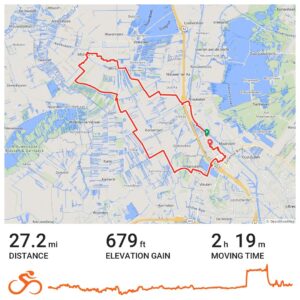 After three weeks in the Netherlands, I am finally figuring out the difference between fietsing and cycling.
After three weeks in the Netherlands, I am finally figuring out the difference between fietsing and cycling.
In my life I have tried to do both.
Fietsing is using a bike, or an e-bike, to handle necessary chores. You fiets to work, you fiets to shopping, you fiets the kids to school. The standard Dutch bike design, your torso vertical, is perfect for fietsing.
Fietsing has a comfort limit of about 5 miles, or a half hour of saddle time. The limit is longer in Atlanta, where a lack of bike traffic means I usually average 13 mph, or 20 kph. OnDutch paths, where you’re usually fighting bike traffic, speeds are often less than 10 mph or 15 kph, although the limit is 15 mph, or 25.
Cycling is entirely different from fietsing. Whether you’re riding with or without electricity, the destination isn’t as important as the trip. Spandex-clad cyclists on Dutch paths, whether alone or in groups, get into a Zen with the bike, thinking only about what they’re doing. On the Silver Comet trail near Atlanta, I call the parking lots where people drive up with their bikes “take-outs,” as though we were canoeing up and down a river.
There are people who cycle to work, often for even longer than an hour. But the cycle and the work are different modes of thought. When you’re fietsing, they’re not.
The Road to Mijdrecht

I realized on that road that the difference between fietsing and cycling isn’t just psychological. It’s physical. A cyclist keeps their weight on their feet, in their thighs, or between their legs. (There’s a chafing issue we won’t talk about.) Sounds nasty, but in practice it means you can cycle for hours using a leather saddle with minimal strain. When you’re fietsing, all the weight sits on your butt. Two hours of saddle time is a lot when you’re fietsing. Maybe it’s too much.
I didn’t see any other fietsers taking my journey. I saw bikes, I saw cyclists, I saw cargo bikes and plenty of motorcycles, but nothing like the Swapfiets I was on. I did see fietsers, but they were taking short jaunts between specific destinations.
You don’t fiets over distance, in other words. You cycle.
The Technology Picture

Bikes used for cycling are streamlined, they come with lots of accessories, and they’re specialized. Get the toe clips or the clip-on shoes, the spandex shorts and top, then cover yourself in advertising like a Daytona stock car driver. Hopefully you’ve got the helmet.
The limits of current battery design adapt well to fietsing. E-bike batteries offer a range of 40 miles (70 km), but you want to recharge at about half that. The limited range makes them the family car, or station wagon, and that’s just how they’re used, the kids in a bucket on the front.
What about Class 3s, you ask, those fat-tired things that race around the neighborhood? Those are mostly kids, they don’t go far, and the kids aren’t really going anywhere. Their short range means they can’t go anywhere even if they want to.
Then there are the motorcycles, which I hate. For good reason. Gas tanks give them a range of 200 miles, or 300 km, at freeway speeds. What they’re doing is driving. They’re cars. They’re cars, cheating everyone else by using the bike path. They need to be pushed off. Take their license when they’re caught and devote resources to catching them.
Make the bike paths safe for fietsers during the week and cyclists on the weekend. We’ll deal with better batteries, their longer ranges at speed, when they arrive next year.
Just let’s understand what we’re talking about first.










